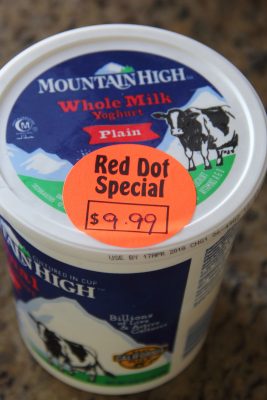Have you ever been in to a supermarket and noticed a round bright fluorescent orange sticker stamped on various packaged food items? Would you buy the item(s) on sale? No? Why not?
Whilst on a recent shopping trip here (in Barbados) at one of the chain supermarkets that can be found across the region, I happened to be standing next to a woman at the gourmet cheese section. She was inspecting packages of goat cheese that were red dot specials and I was getting a wedge of Roquefort (which unfortunately I have never seen as a red dot special because it is always in demand). I could sense the woman’s hesitation at getting the red dot special goat cheese – she kept picking it up, putting it down while whispering the use by date under her breath. I looked at her and we smiled, then she said, “I don’t know if to get this cheese, because it says use by (she gave the date), that’s tomorrow. What do you think?” “Get it,” I told her. “That cheese will be just as good next week.”
All of the items you see with a red dot label carry one of the following dates on their packaging: use by date, sell by date or display until date. These dates can be very confusing for us consumers. Do you know what do they mean? The use by date says that the product is fresh, and safe to consume up until the date on the label, beyond that date, there may be some deterioration of the product in look/appearance, nutritional value or a standard set by the food authorities for such items with regard to public health and safety. The sell by and display dates have nothing to do with food safety; both dates were introduced by supermarkets and manufacturers to rotate stock and indicate quality. These are the dates by which supermarkets determine their specials. Is it safe to buy red dot special items then? Yes. Should you? Yes, if you apply some old-fashioned common sense to choosing your food, and if you want to save a few dollars too.

Of the 3 dates, the one that you need to pay most attention to is the use by date because that is the date that speaks directly to the issue of food safety. However, as I said just now, the application of common sense is your best approach. Long before refrigeration and modern methods of preservation, we determined if our food and drink were safe for human consumption by touching it, feeling it and sniffing it. Therefore, if you walk into a supermarket and see a red dot special with the use by date as the same day you are shopping, chances are it is safe for you to eat it the same day; if it is a dairy product, it is likely to still be edible a couple of days later or more just as long as you carefully inspect it before purchasing (including checking for proper seal and packaging) and storing it properly once you get home. I have bought dairy products such as yogurt, sour cream, crème fraiche, and gourmet cheeses all on red dot specials with the use by date just the day before or on the date itself and not used them until a week later. All good; all excellent tasting. For full disclosure, I must tell you that the red dot special cheeses and other items I mentioned that I buy, I only get the ones that come in their original packaging because that is a guarantee of origin. There are certain red dot special items though that I stay clear of and those would be cooked items such as store-made or locally-sourced goods like sweet bread, biscuits, cakes or cookies. My reason for avoiding such items are two-fold: one, because those are things I can make myself, and secondly, those are not items created for a long shelf-life and they do lose their quality of taste and texture if not consumed within a couple of days of being made. To keep them fresh and longer, they would have had to be carefully and securely wrapped after cooling when cooked and then be frozen.
Deli meats are sometimes on red dot specials too, and they can last a couple of days after the use by date. However, as I have said before, thoroughly check the items before tossing them into your basket or trolley. I once saw mould on the back of some originally packaged slices of salami and pancetta, however, the front of the package and slices looked fresh and were mould free. The bottom line is to inspect before you buy.
Now the other 2 dates that are there for only stock rotation and sales – sell by and display until – you can easily ignore. Stock up if they are specials. Companies prefer to sell their goods at full price which increases their profits so the quicker they move stock, the better. And don’t think that they are losing anything with their red dot specials, that has already been factored in to the overall pricing and operation costs. The one cautionary thing I will say is this – when buying certain long-shelf items always take into consideration the stock turnover. There are some supermarkets with regular and high-volume shopping where the items you are interested in are constantly being restocked and others where things move slowly. Also, always take into consideration that things are being stored under the right conditions. A typical supermarket is cool temperature wise with certain sections colder than others.
So, the next time you come across a red dot special in any supermarket, remember the use by date is about food safety and regulations, it’s the date that matters. The sell by and display until dates are for stock rotation. Take a commonsense approach to your shopping – touch it, feel it, sniff it, and inspect it, carefully.
Cynthia







